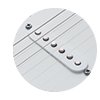Have you ever wondered how your favourite guitar tone was created? Most of us have. It’s not uncommon to hear a great guitar riff and then want to be able to reproduce the sound that initially drew you in. When trying to work out how to replicate that perfect tone, there are four major elements of most recorded guitar parts that need to be considered. I call these the Four Elements of Guitar Tone.
Contributed by Josh Munday – Tone Designer
► The guitar: There is a lot to consider with this element. Guitar make and model, woods used (body and neck)  and pickups (type and brand)
and pickups (type and brand)
► The pickup selection: This could be bridge, neck, middle or any other possible combination (not to mention the active and passive pickup variations)
► The amp: This includes the EQ, level of gain and the speaker cabinet used
 ► The effects: This final element includes any effect adding during the recording process and/or post-production effects that are added after the recording is done. Another effect type is the technique used to record the first three elements (including room type and mic position).
► The effects: This final element includes any effect adding during the recording process and/or post-production effects that are added after the recording is done. Another effect type is the technique used to record the first three elements (including room type and mic position).
In the past, the only way you could replicate your favourite tone/s was to learn how to hear the Four Elements of Guitar Tone and then reproduce them as best you could with the gear you had access to. Of course we don’t all have ready access to a 1968 Fender Stratocaster (strung upside down perhaps), a 1952 butterscotch Fender Telecaster, a cherry-hued 1957 Gibson Les Paul or our very own Red Special. Fewer of us have the skillset and determination to create perfect tone by building the perfect Frankenstrat ourselves.
 Even if you did have that amazing collection of guitars, you’ve only potentially covered two of the Four Elements of Guitar Tone. Unless you were incredibly wealthy or worked in the largest of guitar superstores, you didn’t have access to all known pedal manufacturers and the complete amplifier catalogue from the likes of Marshall, Fender, Orange, Vox and Mesa Boogie. Clearly, without access to all of the same gear your idols were using, it was much more difficult to work out which pieces of gear contributed towards the tone you were chasing.
Even if you did have that amazing collection of guitars, you’ve only potentially covered two of the Four Elements of Guitar Tone. Unless you were incredibly wealthy or worked in the largest of guitar superstores, you didn’t have access to all known pedal manufacturers and the complete amplifier catalogue from the likes of Marshall, Fender, Orange, Vox and Mesa Boogie. Clearly, without access to all of the same gear your idols were using, it was much more difficult to work out which pieces of gear contributed towards the tone you were chasing.
Today, we have the Internet. This has made researching the gear that was used to create your favourite guitar tone a lot easier. This is therefore the most logical starting point for the majority of us as we head down the path of chasing that perfect tone. By today’s standards though, that is still a lot of effort. Surely there’s an easier way to create the tone you’re after. Luckily, there is.
In future articles I’ll be covering some specific examples from my BOSS ME-80 Classic Patches Medley and showing you how to easily create these tones yourself using an amp simulator multi-effects unit. The techniques I’ll be showing you will work with any good quality gear. If programming your tones is too involved for your skillset and/or liking, then never fear. I’ll also be providing ready-made patches that I’ve designed on a variety of BOSS and Roland gear. Stay tuned!
Related Article
Related Product
- ME-80
- Hands-On Access to a World of Great Tones.



